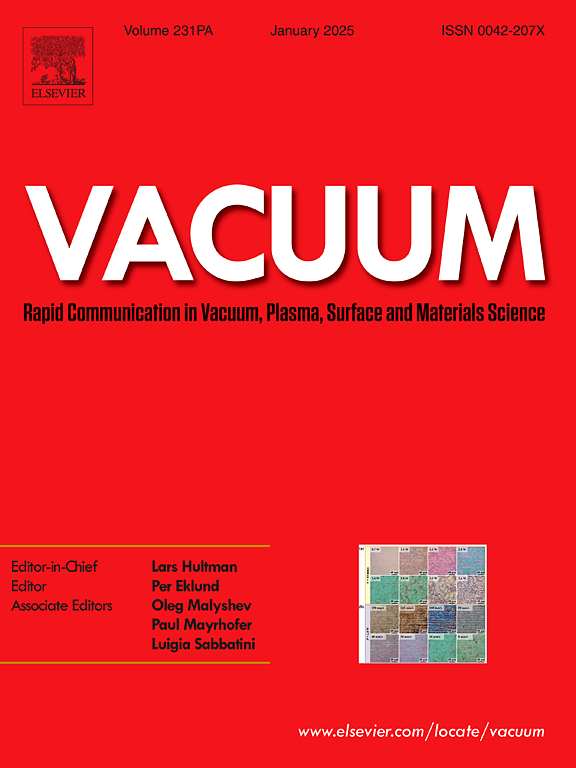Reduction of iron oxide (alpha-Fe2O3) with a hydrogen rich plasma produced by an Electron Cyclotron Wave Resonance source
IF 3.9
2区 材料科学
Q2 MATERIALS SCIENCE, MULTIDISCIPLINARY
引用次数: 0
Abstract
To establish a permanent settlement on the Moon, it is essential to find solutions for producing oxygen (O2) and water (H2O). One promising method is the in-situ production of H2O through the thermal reduction of lunar regolith containing iron oxide (Fe2O3). This study explores the use of Electron Cyclotron Wave Resonance (ECWR) plasma for reducing Fe2O3, comparing its energy efficiency to traditional hydrogen (H2) thermal reduction. Experiments were conducted using an H2/Ar plasma mixture on Fe2O3 thin films at varying substrate temperatures and treatment times. Characterization techniques revealed a multilayer structure forming during the reduction, with a rapid transition to metallic iron (Fe) on the surface after 15 min of treatment. An intermediate Fe3O4 layer developed with extended reduction time, resulting in a distinct three-layered structure. Controlled heating above 200 °C significantly accelerated the reduction process while maintaining the same mechanism. Energy efficiency calculations indicate that H2/Ar ECWR plasma can be up to six times more efficient than simple thermal reduction, highlighting its potential as an effective method for lunar oxygen production.
用电子回旋波共振源产生的富氢等离子体还原氧化铁(α - fe2o3)
为了在月球上建立永久定居点,找到生产氧气(O2)和水(H2O)的解决方案至关重要。一种很有前途的方法是通过热还原含有氧化铁(Fe2O3)的月球风化层来原位生产水。本研究探索了利用电子回旋波共振(ECWR)等离子体还原Fe2O3,并将其能量效率与传统的氢(H2)热还原进行了比较。在不同的衬底温度和处理时间下,利用H2/Ar等离子体混合物在Fe2O3薄膜上进行了实验。表征技术表明,在还原过程中形成多层结构,处理15分钟后表面迅速转变为金属铁(Fe)。随着还原时间的延长,中间Fe3O4层逐渐形成,形成明显的三层结构。200°C以上的加热控制显著加速了还原过程,同时保持了相同的机理。能源效率计算表明,H2/Ar ECWR等离子体的效率是简单热还原的6倍,这凸显了它作为一种有效的月球氧气生产方法的潜力。
本文章由计算机程序翻译,如有差异,请以英文原文为准。
求助全文
约1分钟内获得全文
求助全文
来源期刊

Vacuum
工程技术-材料科学:综合
CiteScore
6.80
自引率
17.50%
发文量
0
审稿时长
34 days
期刊介绍:
Vacuum is an international rapid publications journal with a focus on short communication. All papers are peer-reviewed, with the review process for short communication geared towards very fast turnaround times. The journal also published full research papers, thematic issues and selected papers from leading conferences.
A report in Vacuum should represent a major advance in an area that involves a controlled environment at pressures of one atmosphere or below.
The scope of the journal includes:
1. Vacuum; original developments in vacuum pumping and instrumentation, vacuum measurement, vacuum gas dynamics, gas-surface interactions, surface treatment for UHV applications and low outgassing, vacuum melting, sintering, and vacuum metrology. Technology and solutions for large-scale facilities (e.g., particle accelerators and fusion devices). New instrumentation ( e.g., detectors and electron microscopes).
2. Plasma science; advances in PVD, CVD, plasma-assisted CVD, ion sources, deposition processes and analysis.
3. Surface science; surface engineering, surface chemistry, surface analysis, crystal growth, ion-surface interactions and etching, nanometer-scale processing, surface modification.
4. Materials science; novel functional or structural materials. Metals, ceramics, and polymers. Experiments, simulations, and modelling for understanding structure-property relationships. Thin films and coatings. Nanostructures and ion implantation.
 求助内容:
求助内容: 应助结果提醒方式:
应助结果提醒方式:


